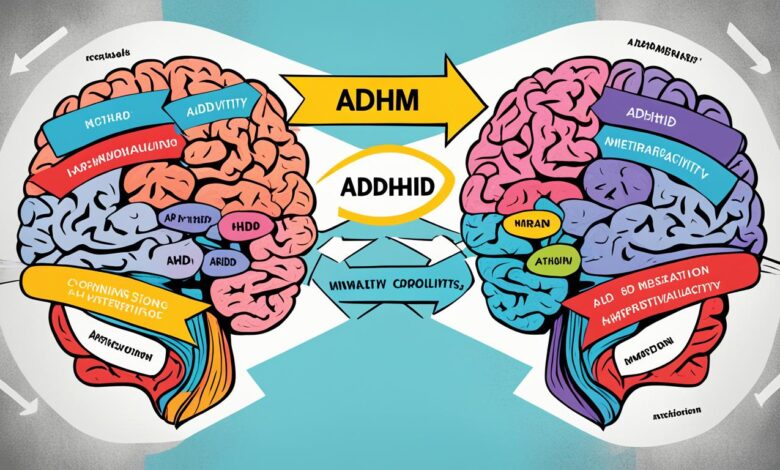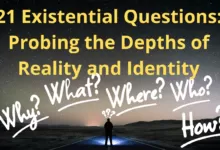ADHD Guide: Types, Symptoms, and Treatments

Imagine steering a ship across the vast ocean, facing waves of distraction. Your focus is essential to navigate through these challenges. This is like the daily experience of those with Attention Deficit Hyperactivity Disorder ADHD affects both kids and adults, bringing unique struggles and strength. In this guide, we will explore ADHD’s nature, including its types, symptoms, and ways to manage it. We aim to move towards hope and better functionality.
ADHD’s challenges vary widely among individuals. However, those affected share common experiences—misunderstandings, creative outbursts, and a quest for balance. Let’s approach this with compassion and seek understanding. We’ll explore ADHD’s impact and the treatments available. Our goal is to improve life quality for those with ADHD.
Understanding ADHD in Children and Adults
ADHD affects both kids and adults, leading to challenges in behavior. It’s now more commonly diagnosed than before. People with ADHD may struggle with attention, hyperactivity, and impulsivity. These issues can impact school, work, and relationships.
What is ADHD?
ADHD in children shows up as trouble focusing, acting without thinking, or being too active. For ADHD in adults, it’s more about problems with organizing, managing time, and keeping a job. Though ADHD symptoms change with age, they have a consistent theme.
Who is Affected by ADHD?
Boys get ADHD diagnoses about twice as often as girls. But, ADHD can affect anyone, no matter their gender. In the U.S, kids are usually diagnosed at seven years old. Early help is key to handling ADHD well.
Many people live with ADHD. The table below shows how common ADHD is in different age groups:
| Age Range | Prevalence in Children (%) | Prevalence in Adults (%) |
|---|---|---|
| 4-11 Years | 9.6 | – |
| 12-17 Years | 9.0 | – |
| 18 Years and Above | – | 4.4 |
These statistics highlight the importance of a personalized approach to ADHD care. Understanding each person’s unique symptoms is critical for effective treatment.
Learning about ADHD means removing stigma and offering the right help. Whether it’s ADHD in children or ADHD in adults, awareness and supportive care matter for everyone.
ADHD: Types, Symptoms, and Treatment Options
Learning about the different types of ADHD is key in tackling this complex disorder. Each form of ADHD comes with unique challenges. It’s important to spot both obvious and subtle signs to choose the right ADHD treatment options. This article covers the three main types of ADHD and discusses specific ways to manage each one.
People with inattentive ADHD might forget things and have trouble paying attention. They might also get distracted easily. The hyperactive-impulsive type often involves being fidgety, unable to stay seated, and acting without thinking. The combined type means someone may have symptoms of both, making their treatment more challenging.
Getting the right diagnosis is the first step to effective treatment. This diagnosis guides the selection of therapy, behavior strategies, or medication. Each ADHD treatment option aims to lessen symptoms to help improve everyday life and overall well-being. We will see how each treatment fits the different types of ADHD.
| ADHD Type | Main Symptoms | Treatment Approaches |
|---|---|---|
| Inattentive Type | Lack of focus, disorganization, easy distraction | Cognitive-behavioral therapy, organization skills training, stimulant and non-stimulant medications |
| Hyperactive-Impulsive Type | Excessive energy, impatience, difficulty with impulse control | Behavioral intervention strategies, social skills training, environmental modifications, stimulant medications |
| Combined Type | Symptoms of both inattentive and hyperactive-impulsive types | Combination of therapies suitable for inattentive and hyperactive-impulsive types, balanced medication approach |
Beyond just focusing on ADHD types, it’s crucial to consider the person’s specific needs. This includes any other conditions they might have, lifestyle, and what they prefer. Treatment plans should evolve based on how symptoms change and what’s happening in someone’s life.
Identifying the Types of ADHD
It’s important to know the different types of Attention Deficit Hyperactivity Disorder for the right treatment. Each type shows specific traits that help doctors and caregivers come up with the best care plan. We will look into the unique features of the ADHD inattentive type, ADHD hyperactive-impulsive type, and ADHD combined type.
Inattentive Type ADHD
The ADHD inattentive type makes focusing and staying organized hard. Kids may seem lost in thought, have a hard time following directions, and forget daily tasks. This type is often seen more in girls, stressing the need for attention to gender differences in treatment.
Hyperactive-Impulsive Type ADHD
The ADHD hyperactive-impulsive type involves lots of energy and sudden actions. Individuals might not stay seated, talk a lot, and interrupt others. It’s more common in boys, affecting how they act and learn in school.
Combined Type ADHD
The ADHD combined type includes symptoms of both inattention and hyperactivity-impulsivity. It’s the type most kids are diagnosed with. Having both types of symptoms makes managing ADHD more challenging.
| ADHD Type | Core Symptoms | Common in Gender | Treatment Focus |
|---|---|---|---|
| Inattentive | Poor concentration, distractibility, disorganization | Girls | Behavioral strategies, organizational skills training |
| Hyperactive-Impulsive | Restlessness, excessive talking, impatience | Boys | Activity scheduling, impulse control techniques |
| Combined | A mix of inattentive and hyperactive-impulsive symptoms | Boys | Comprehensive approach, combination of treatments |
Understanding ADHD’s complexities is vital for effective, personalized care. By identifying the traits of the ADHD inattentive type, the ADHD hyperactive-impulsive type, and the ADHD combined type, experts can create treatments that meet each individual’s needs. This approach makes managing ADHD a path of thoughtful care and specific actions.
Recognizing the Symptoms of ADHD
Spotting ADHD symptoms early is key to a timely diagnosis. This helps start managing ADHD symptoms sooner. Noticing details, like missing small things which could cause problems at school or work, is crucial. It’s important to understand how these symptoms show up.
Both kids and adults with ADHD find it hard to keep focusing. This might look like they’re not interested or motivated. But, actually, it’s part of the challenge with ADHD. Being easily distracted or forgetting things often are big signs too.
Moving around a lot, like fidgeting or not being able to sit still, can be misunderstood. People might think it means someone can’t focus. But these are just symptoms of ADHD.
Talking too much, cutting off others, or speaking out of turn may seem rude. However, it’s really part of the condition. ADHD can make waiting your turn or understanding personal space hard, affecting friendships and social life.
Seeing these symptoms regularly, not just once in a while, is important. Symptoms should last at least six months and not match the person’s age well to consider an ADHD diagnosis.
In conclusion, recognizing and managing ADHD symptoms takes careful observation. It requires understanding these actions are not single events, but part of a bigger picture. A detailed plan that looks at the reasons and impacts of ADHD is key. This helps those with ADHD live organized and happy lives.
ADHD Diagnosis: More Than Just a Simple Test
Getting an ADHD diagnosis is vital for those showing signs and their families. ADHD isn’t identified with just one test. Instead, it needs detailed evaluation to fully understand someone’s behavior.
Criteria for Diagnosing ADHD in Children
ADHD in children requires a careful approach for diagnosis. Doctors use the DSM-5 to find certain behaviors that stand out. A child needs to show at least six key symptoms for over six months in more than one place, like home and school. These symptoms should start before the child turns 12 and cause noticeable disruptions.
Assessing ADHD in Adults
Finding ADHD in adults is often harder. Adults might need a second look if they were not diagnosed as kids or face new challenges. This includes checking past and present behaviors and how they affect daily life. As ADHD changes over time, continuous evaluations help keep treatments useful and tailored to each person.
Exploring Treatment Options for ADHD
Managing Attention Deficit Hyperactivity Disorder involves several strategies. Treatment includes medication for neurochemical imbalances and therapy for better behavior and coping. There are also support options for individuals and families. Each method has its own benefits. Finding the right mix is key to managing symptoms effectively.
Behavioral Therapy and Support
Behavioral therapy is a primary treatment, especially for kids. It helps them learn skills to handle disruptive behaviors and improve in social settings, organization, and school. Support options like advocacy groups provide additional resources. They give emotional support and help apply therapy techniques in daily life.
Medication Choices for ADHD
ADHD medication plays a big role in treatment plans. Stimulants, like methylphenidate and amphetamines, are common. They improve focus and control hyperactivity. These medications are part of a broader management strategy.
Nonstimulant Medications
Sometimes, stimulants aren’t the right fit due to side effects or lack of effectiveness. Nonstimulant medications are an alternative. These include atomoxetine and some antidepressants. They work differently from stimulants but still aid in managing attention and impulses. Doctors consider each person’s unique situation and past treatment responses before prescribing.
Lifestyle and Self-Management Strategies
Lifestyle changes and self-management are critical in ADHD treatment. Consistent routines, physical activity, and a healthy diet support brain health. Cognitive-behavioral strategies change negative thoughts. ADHD coaching helps with organization and time management.
| Treatment Method | Benefits | Considerations |
|---|---|---|
| Behavioral Therapy | Improves behavior and social skills | Requires consistent effort and may involve the whole family |
| Stimulant Medications | Increases attention, reduces impulsivity | Potential side effects; regular monitoring necessary |
| Nonstimulant Medications | Alternative for those who don’t respond to stimulants | May take longer to see improvements |
| Lifestyle Changes | Supports overall well-being and complements other treatments | Requires long-term commitment and lifestyle adjustment |
| Support Groups | Provides emotional support and practical advice | May differ in availability and focus |
Conclusion
ADHD is more than just symptoms. It’s a complex disorder needing special care. Recognizing it early is the first crucial step. Then, combining therapy and medication can greatly improve daily life for those with ADHD. Support groups play a big role too, offering a space to grow and learn.
Grasping the full picture of ADHD is key for effective management. A plan tailored to the individual, made with doctors, is essential. This plan focuses on personal needs, showing there’s no one-size-fits-all solution for ADHD.
Realizing ADHD’s big impact on lives, it’s comforting to know there are many resources out there. Patient-centered approaches are valuable, promoting education and a comprehensive view of treatment. Through various support options, those with ADHD can find a supportive community. This leads to a more organized and happier life.








